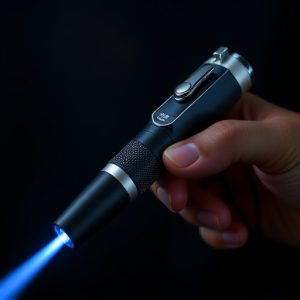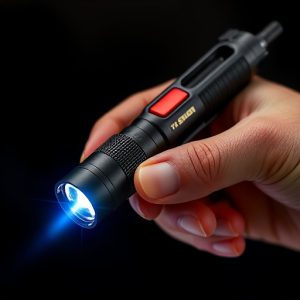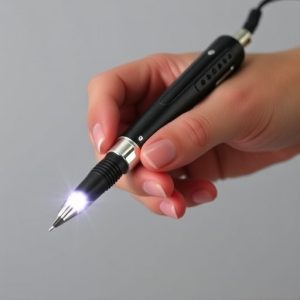Pen Stun Guns: Duration of Muscle Incapitation & Safety Insights
Pen stun guns, compact self-defense tools, use high-voltage, low-amperage electric shocks to tempora…….
Pen stun guns, compact self-defense tools, use high-voltage, low-amperage electric shocks to temporarily paralyze aggressors through conductive tips, affecting muscle contraction. Effectiveness varies based on voltage, targeted area, and health, typically 3-5 minutes, but recovery time is shorter (10-15 minutes). Legal regulations differ globally; safe handling, training, and understanding device parameters are crucial to mitigate risks.
“Discover the surprising world of pen stun guns, a non-lethal self-defense tool gaining popularity. This article offers a comprehensive guide to understanding these compact devices. We’ll explore the science behind their muscle incapacitation capabilities, delving into the duration of effects and recovery times. Additionally, legal considerations and safety precautions are discussed, providing essential insights for informed use. Uncover the key factors that make pen stun guns an effective yet responsible option for personal safety.”
- Understanding Pen Stun Guns: A Brief Overview
- The Science Behind Muscle Incapitation
- Duration of Effect and Recovery Time
- Legal Considerations and Safety Precautions
Understanding Pen Stun Guns: A Brief Overview
Pen stun guns, also known as personal stun devices or electric stun pens, are compact and easily concealed self-defense tools designed to temporarily incapacitate an aggressor. These innovative gadgets deliver a powerful electric shock through contact or proximity, making them effective for individuals seeking protection in various situations. The technology behind pen stun guns involves high-voltage, low-amperage electrical current, which disrupts the muscles’ ability to contract, causing temporary paralysis and immobilization.
Unlike traditional stun guns that fire a charged probe, pen stun guns use conductive tips or surfaces to transfer electricity directly to the target. This design makes them easier to wield and less likely to cause collateral damage. The duration of muscle incapacitation from a pen stun gun varies depending on factors such as the device’s voltage output, the area targeted, and the aggressor’s overall health. In general, users can expect their opponent to remain temporarily paralyzed for several seconds to a minute, providing enough time to escape or summon help.
The Science Behind Muscle Incapitation
The effect of a pen stun gun on muscle incapacitation is rooted in its ability to deliver an electrical charge, disrupting the nerve signals that control muscular movement. When activated, these devices emit a high-voltage, low-amperage electric pulse, which can temporarily paralyze muscles by overloading and damaging the motor neurons responsible for contraction. This results in a rapid loss of strength and control, rendering the targeted individual immobile for several moments.
The duration of muscle incapacitation from a pen stun gun varies based on factors such as the device’s power output, the specific body part targeted, and the individual’s physical condition. Typically, the effects can last from a few seconds to a minute or more, during which time the person affected may experience muscle twitching, loss of balance, and difficulty performing fine motor tasks. Understanding these scientific principles is crucial for both users and law enforcement alike, as it helps in assessing the effectiveness of stun guns and ensuring their safe and responsible use.
Duration of Effect and Recovery Time
The duration of effect from a pen stun gun varies depending on several factors, including the model, power output, and physical attributes of the target. On average, a single shot from a quality pen stun gun can incapacitate an individual for 3 to 5 minutes. This period provides enough time for emergency services to arrive, ensuring public safety.
Recovery time, however, is typically shorter. Most individuals affected by a pen stun gun will regain consciousness and mobility within 10 to 15 minutes. Some factors can speed up recovery, such as younger age and better overall health. In contrast, older adults or those with pre-existing medical conditions may take closer to 20 minutes or more to fully recover.
Legal Considerations and Safety Precautions
The use of pen stun guns, also known as electroshock weapons, is governed by a web of legal and safety considerations. It’s crucial to understand that their application varies significantly across jurisdictions. Some countries and states permit their possession only for security purposes or by authorized personnel, while others restrict or outright ban them. Users must familiarize themselves with local laws to ensure compliance, avoiding potential legal repercussions.
Safety precautions are paramount when handling pen stun guns. These devices emit electric currents designed to temporarily incapacitate targets, but they carry risks. Misuse can lead to severe physical harm or even death. Responsible users should prioritize safety measures like proper training, understanding the weapon’s range and power settings, and ensuring safe storage to prevent accidental discharge.
Pen stun guns, while effective for self-defense, have varying muscle incapacitation durations, with effects typically lasting from a few seconds to several minutes. The exact length depends on factors such as the device’s power output and the target’s size and resistance. Understanding these variables is crucial for users to employ these devices responsibly and within legal boundaries. Always prioritize safety precautions and stay informed about local regulations regarding stun guns, especially when considering their use for self-defense or law enforcement purposes.


